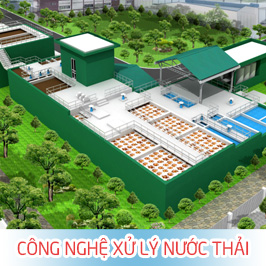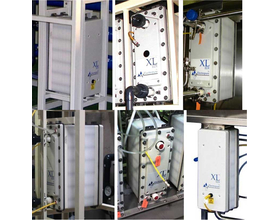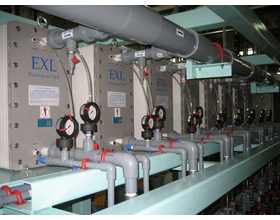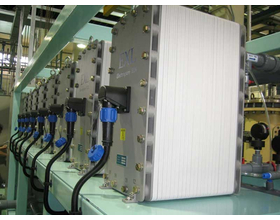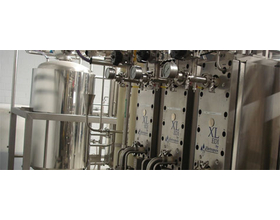Description
EDI SYSTEMS - ELECTRODEIONIZATION (EDI)
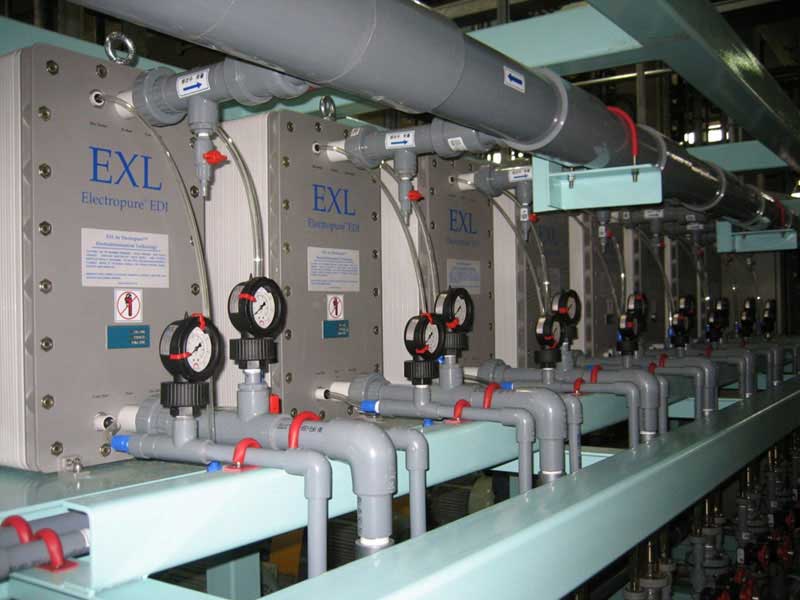
Manufacturers: SNOWPURE - USA
Benefits and Advantages of Electropure™ Technology
There are three key advantages in Electropure™ Technology. These enable Electropure™ EDI to have higher efficiency, and longer life with less maintenance and fewer problems.
- Bản quyền công nghệ màng Excellion (1998) nghiên cứu riêng cho công nghệ EDI, giúp tăng hiệu quả tách ion, giảm ngẹt màng.
- Với công nghệ Mass-Tranfer và Thin-Concentrate thiết kế tối ưu cho Snowpure EDI với khoảng cách 4mm giữa các màng đồng thời với lớp ngăn cách 700nm làm bằng vải không dệt tạo ra lớp nhiễu loạn bề mặt màng => ngăn ngừa sự đóng cặn. Không bị trouble như công nghệ tuần hoàn nước cô đặc Omexell và E-Cell, không cần sử dụng công nghệ all-fill như của Ionpure (O’Hare đã phát minh ra năm 1981 nhưng không sử dụng do dễ ngẹt khi nồng độ đầu vào cao).
- Bản quyền công nghệ Electropure EDI (O’Hare 1984) của Snowpure, có bán bản quyền cho GE Water phát triển E-Cell (hiện tại là Suez EDI)
- Thin-Cell Technology. Electropure™ EDI has always had thin cells. In EDI, there is a physical competition to drive ions horizontally across the cell before they leave the top of the cell. Electropure™ XL cells are 4mm wide, as compared to Ionpure® and E-Cell® which have cells about 10 mm wide. This allows higher water quality and higher efficiency.
- Thin-Concentrate Technology. Electropure™ EDI uses a very thin concentrate, about 700 microns thick. It is made up of very thin woven fibers. This design creates turbulence at the membrane surface, keeping the membrane surfaces clean and close to pH 7, preventing fouling and scaling. The thin design also keeps the current low. Electropure™ avoids the use of a “filled concentrate” which can foul. The all-filled design was contemplated in the 1981 O’Hare patent, but was rejected because of its long-term problems.
- Non-fouling Electrode Technology. Electropure™ EDI uses a special anode technology to limit the production of chlorine, which lengthens the life of the EDI module. It also uses a proprietary design which keeps the electrodes always on the acidic side, preventing scaling in the electrodes.
With these technologies, we find that scaling in systems is extremely rare. EDI module lifetime is designed be long (longest life seen so far is 15 years). SnowPure intentionally uses technologies in its products that minimize maintenance and maximize module lifetime.

What is EDI?
High purity water production has traditionally used a combination of membrane separation and ion exchange processes. EDI is a process which combines semi-impermeable membrane technology with ion-exchange media to provide a high efficiency demineralization process.
Electro dialysis employ electrical current and specially-prepared membranes which are semi permeable to ions based on their charge, electrical current, and ability to reduce the ions based to their charge. Through electro dialysis an electrical potential transports and segregates charged aqueous species. The electrical current is used to continuously regenerate the resin, eliminating the need for periodical regeneration.
The EDI process produces industrial process water of very high purity, using less than 95% of the chemical products used in the conventional ion exchange processes. With EDI system membranes and electricity replace the million gallons of acid and caustic chemicals that the old processes required daily.
How does it work?
An EDI stack has the basic structure of a deionization chamber. The chamber contains a ion exchange resin, packed between a cationic exchange membrane and a anionic exchange membrane. Only the ions can pass through the membrane, the water is blocked.
When flow enters the resin filled diluiting compartment, several processes are set in motion. Strong ions are scavenged out of the feed stream by the mixed bed resins. Under the influence of the strong direct current field applied across the stack of components, charged ions are pulled off the resin and drawn towards the respective, oppositely-charged electrodes. In this way these charged strong-ion species are continuously removed and transferred in to the adiacent concentrating compartments.
As the ions go towards the membrane, they can pass through the concentration chamber (see figure) but they cannot reach the electrode. They are blocked by the contiguous membrane, that contains a resin with the same charge.
As the strong ions are removed from the process stream, the conductivity of the stream becomes quite low. The strong, applied electrical potential splits water at the surface of the resin beads, producing hydrogen and hydroxyl ions. These act as continuous regenerating agents of the ion-exchange resin. These regenerated resins allow ionization of neutral or weakly-ionized aqueous species such as carbon dioxide or silica. Ionization is followed by removal through the direct current and the ion exchange membranes.
The ionization reactions occurring in the resin in hydrogen or hydroxide forms for the removal of weakly ionized compounds are listed below:
CO2 + OH- ==> HCO3-
HCO3- + OH- ==> CO32-
SiO2 + OH- ==> HSiO3-
H3BO3 + OH- ==> B(OH)4-
NH3 + H+ ==> NH4+
Applications
EDI is useful for any application that requires constant and economic removal of water impurities without using dangerous chemical. Some examples are:
- Reuse of residual water in food and beverages industry
- Chemical production
- Biotechnology
- Electronics
- Cosmetic
- Laboratories
- Pharmaceutical industry
- Boiler Feed Water
- Reduction of ionizable SiO2 and TOC (total organic carbon)
Since installation EDI units perform quite reliably, providing the customers with high purity production water for either power plant boiler feed or microchip rinse water. The water produced has met or exceeded customer high-purity water specifications. In addition, when a diluite stream cleaning was required as result of fouling, product quality was completely recovered.
Advantages
As a substitute for the more traditional ion-exchange process, EDI brings advances in both energy and operating expenses to the high purity water treatment train. By eliminating the periodic regeneration requirement of ion exchange resin, environmental benefits are also realized by avoiding the handling and processing of acid and caustic chemicals brought to the site.
Some of the advantages of the EDI as opposed to the conventional systems of ionic interchange are:
- Simple and continuous operation
- Chemicals for regeneration completely eliminated
- Cost effective operation and maintenance
- Low power consumption
- Non pollution, safety and reliablility
- It requires very few automatic valves or complex control sequences that need supervision by an operator
- It requires little space
- It produces high pure water in a constant flow
- It provides complete removal of dissolved inorganic particles
- In combination with reverse osmosis pre-treatment, it removes more than 99.9% of ions from the water
Disadvantages
- EDI cannot be used for water having hardness higher than 1, since the calcium carbonate would create a scab in the camera of the concentrated one, limiting the operation
- It requires purification pretreatment
- Carbon Dioxide will freely pass through an RO membrane, dissociating and raising the conductivity of water. Any ionic species formed from the carbon dioxide gas will lower the outlet resistivity of the water produced by EDI. The management of CO2 in water is typically handled in one or two ways: the pH of the water can be adjusted to allow the RO membrane to rejuect the ionic species or the carbon dioxied can be removed from the water using a strip gas.






















